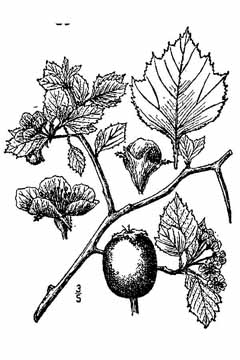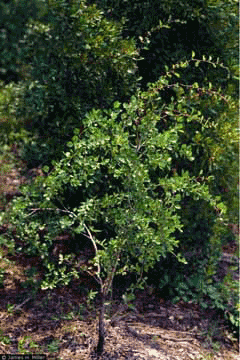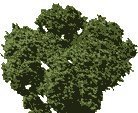 |
|
USDA-NRCS PLANTS Database / Britton, N.L., and A. Brown. 1913. An illustrated flora of the northern United States, Canada and the British Possessions. Vol. 2: 310. |
 |
| James H. Miller @ USDA-NRCS PLANTS Database / Miller, J.H. and K.V. Miller. 2005. Forest plants of the southeast and their wildlife uses. University of Georgia Press, Athens. |
Translate this page:
Summary
Summer Haw (C. flava), found in open woods and low hills in dry sandy or gravelly soils, is highly esteemed in N. America for its yellow pear-shaped fruit gathered for making jellies. Hawthorns are shrubs or small trees with small fruit and thorny branches. They have clusters of creamy-white flowers followed by red or black fruit. They are part of the rose family (apples, pears, plums, cherries, peaches and apricots) and native to temperate regions of the Northern Hemisphere, including Europe and North America. Once established, several Hawthorns succeed in dry soils and tolerate drought. A position in full sun is best when plants are grown for their fruit; they also succeed in semi-shade, though fruit yields and quality will be lower. Most members of this genus thrive in exposed positions and tolerate atmospheric pollution. There are many species with absolutely delicious fruit, easily rivalling cultivated crops. Fruits vary widely from species to species, with the largest fruit size being about an inch (25mm) in diameter. Depending on the species, the fruit flavour goes from bitter to sweet, with the texture going from hard, dry, and powdery to crisp and juicy. Most of the species ripen their fruit in early to mid-autumn.
Physical Characteristics

 Crataegus flava is a deciduous Shrub growing to 8 m (26ft) by 10 m (32ft) at a medium rate.
Crataegus flava is a deciduous Shrub growing to 8 m (26ft) by 10 m (32ft) at a medium rate.
See above for USDA hardiness. It is hardy to UK zone 6 and is not frost tender. It is in flower from May to June. The species is hermaphrodite (has both male and female organs) and is pollinated by Midges. The plant is not self-fertile.
It is noted for attracting wildlife.
Suitable for: light (sandy), medium (loamy) and heavy (clay) soils and can grow in heavy clay soil. Suitable pH: mildly acid, neutral and basic (mildly alkaline) soils and can grow in very alkaline soils.
It can grow in semi-shade (light woodland) or no shade. It prefers dry moist or wet soil and can tolerate drought. The plant can tolerates strong winds but not maritime exposure.
It can tolerate atmospheric pollution.
UK Hardiness Map
US Hardiness Map
Synonyms
Plant Habitats
Woodland Garden Secondary; Sunny Edge; Dappled Shade;
Edible Uses
Edible Parts: Fruit
Edible Uses:
Fruit - raw or cooked[46, 61, 95, 161]. well-flavoured[2]. Dry and mealy[82], it is highly esteemed in N. America as a wild fruit gathered for making jellies[183]. The yellow fruit is pear-shaped[245], it is up to 16mm in diameter and is borne in small clusters[229]. There are up to five fairly large seeds in the centre of the fruit, these often stick together and so the effect is of eating a cherry-like fruit with a single seed[K].
References More on Edible Uses
Medicinal Uses
Plants For A Future can not take any responsibility for any adverse effects from the use of plants. Always seek advice from a professional before using a plant medicinally.
Cardiotonic Hypotensive
Although no specific mention has been seen for this species, the fruits and flowers of many hawthorns are well-known in herbal folk medicine as a heart tonic and modern research has borne out this use. The fruits and flowers have a hypotensive effect as well as acting as a direct and mild heart tonic[222]. They are especially indicated in the treatment of weak heart combined with high blood pressure[222]. Prolonged use is necessary for it to be efficacious[222]. It is normally used either as a tea or a tincture[222].
References More on Medicinal Uses
The Bookshop: Edible Plant Books
Our Latest books on Perennial Plants For Food Forests and Permaculture Gardens in paperback or digital formats.

Edible Tropical Plants
Food Forest Plants for Hotter Conditions: 250+ Plants For Tropical Food Forests & Permaculture Gardens.
More

Edible Temperate Plants
Plants for Your Food Forest: 500 Plants for Temperate Food Forests & Permaculture Gardens.
More

More Books
PFAF have eight books available in paperback and digital formats. Browse the shop for more information.
Shop Now
Other Uses
Hawthorn is often used as a hedge or windbreak, providing habitat for wildlife. It also attracts pollinators and beneficial insects. Wood - heavy, hard, tough, close-grained. Useful for making tool handles, mallets and other small items[82]. 1. Nectary - Flowers rich in nectar and pollen:
Yes – Hawthorn flowers are rich in nectar and pollen, making them highly attractive to pollinators such as bees, flies, and butterflies.
2. Wildlife - Food (Fruit, Seeds, Leaf litter, Shelter, Nesting, Roosting):
Yes – Hawthorn provides food for wildlife, including birds and small mammals, through its fruit (haws) and seeds. The dense, thorny branches offer excellent shelter, and the tree can be used for nesting and roosting by birds.
3. Invertebrate Shelter (Overwintering sites, Leaf litter, Groundcover):
Yes – The rough bark and dense canopy provide overwintering sites for invertebrates. Fallen leaf litter creates a habitat for soil organisms and shelter for beneficial insects.
4. Pest Confuser (Smell):
No – Hawthorn does not have a strong scent that confuses pests.
Special Uses
Scented Plants
References More on Other Uses
Cultivation details
A very easily grown plant, it prefers a well-drained moisture retentive loamy soil but is not at all fussy[11, 200]. Once established, it succeeds in excessively moist soils and also tolerates drought[200]. It grows well on a chalk soil and also in heavy clay soils[200]. A position in full sun is best when plants are being grown for their fruit, they also succeed in semi-shade though fruit yields and quality will be lower in such a position[11, 200]. Most members of this genus succeed in exposed positions, they also tolerate atmospheric pollution[200]. Hybridizes freely with other members of this genus[200]. Seedling trees take from 5 - 8 years before they start bearing fruit, though grafted trees will often flower heavily in their third year[K]. The flowers have a foetid smell somewhat like decaying fish. This attracts midges which are the main means of fertilization. When freshly open, the flowers have more pleasant scent with balsamic undertones[245]. Seedlings should not be left in a seedbed for more than 2 years without being transplanted[11]. The fruit is sparsely produced in Britain[11]. A tree at Kew in September 1993 was fruiting heavily[K]. Some species of Hawthorn are self-fertile, but cross-pollination often improves fruit set. Crataegus flava is not self-fertile. Hawthorn berries are typically harvested in late Summer to early Autumn.
Hawthorn flowers in Spring. Hawthorn grows moderately fast, reaching maturity in about 5-10 years, depending on the species and growing conditions.
References Carbon Farming Information and Carbon Sequestration Information
Temperature Converter
Type a value in the Celsius field to convert the value to Fahrenheit:
Fahrenheit:
The PFAF Bookshop
Plants For A Future have a number of books available in paperback and digital form. Book titles include Edible Plants, Edible Perennials, Edible Trees,Edible Shrubs, Woodland Gardening, and Temperate Food Forest Plants. Our new book is Food Forest Plants For Hotter Conditions (Tropical and Sub-Tropical).
Shop Now
Plant Propagation
Seed - this is best sown as soon as it is ripe in the autumn in a cold frame, some of the seed will germinate in the spring, though most will probably take another year. Stored seed can be very slow and erratic to germinate, it should be warm stratified for 3 months at 15°c and then cold stratified for another 3 months at 4°c[164]. It may still take another 18 months to germinate[78]. Scarifying the seed before stratifying it might reduce this time[80]. Fermenting the seed for a few days in its own pulp may also speed up the germination process[K]. Another possibility is to harvest the seed 'green' (as soon as the embryo has fully developed but before the seedcoat hardens) and sow it immediately in a cold frame. If timed well, it can germinate in the spring[80]. If you are only growing small quantities of plants, it is best to pot up the seedlings as soon as they are large enough to handle and grow them on in individual pots for their first year, planting them out in late spring into nursery beds or their final positions. When growing larger quantities, it might be best to sow them directly outdoors in a seedbed, but with protection from mice and other seed-eating creatures. Grow them on in the seedbed until large enough to plant out, but undercut the roots if they are to be left undisturbed for more than two years.
Other Names
If available other names are mentioned here
Native Range
NORTHERN AMERICA: United States, Alabama, Florida (northwest), Georgia, North Carolina (south), South Carolina, Virginia (east),
Weed Potential
Right plant wrong place. We are currently updating this section.
Please note that a plant may be invasive in one area but may not in your area so it's worth checking.
Conservation Status
IUCN Red List of Threatened Plants Status :

| Related Plants
|
| Latin Name | Common Name | Habit | Height | Hardiness | Growth | Soil | Shade | Moisture | Edible | Medicinal | Other |
| Crataegus acclivis | | Tree | 8.0 |
4-8
| | LMH | SN | MWe | 4 | 2 | |
| Crataegus aestivalis | Eastern Mayhaw, May hawthorn, Mayhaw, Apple Hawthorn | Shrub | 9.0 |
6-11
| M | LMH | SN | MWe | 3 | 2 | 5 |
| Crataegus altaica | Altai Mountain Thorn | Tree | 6.0 |
4-8
| | LMH | SN | MWe | 3 | 2 | 2 |
| Crataegus anomala | Arnold hawthorn | Shrub | 5.0 |
4-8
| | LMH | SN | MWe | 3 | 2 | 3 |
| Crataegus apiifolia | Parsley-Leaved Hawthorn | Shrub | 4.0 |
6-9
| | LMH | SN | MWe | 2 | 2 | 2 |
| Crataegus aprica | Sunny Hawthorn | Tree | 6.0 |
5-9
| | LMH | SN | DMWe | 3 | 2 | 2 |
| Crataegus armena | | Tree | 0.0 |
-
| | LMH | SN | MWe | 2 | 2 | 2 |
| Crataegus arnoldiana | Arnold Hawthorn | Tree | 7.0 |
5-9
| | LMH | SN | DMWe | 5 | 2 | 2 |
| Crataegus atrosanguinea | | Tree | 0.0 |
-
| | LMH | SN | MWe | 3 | 2 | 2 |
| Crataegus azarolus | Azarole | Tree | 10.0 |
5-9
| M | LMH | SN | MWe | 4 | 2 | 2 |
| Crataegus baroussana | Tejocote | Shrub | 2.0 |
0-0
| | LMH | SN | MWe | 4 | 2 | 2 |
| Crataegus caesa | | Shrub | 3.0 |
6-9
| | LMH | SN | MWe | 4 | 2 | 2 |
| Crataegus calpodendron | Pear Hawthorn | Tree | 6.0 |
-
| | LMH | SN | MWe | 3 | 2 | 2 |
| Crataegus canadensis | Canadian hawthorn | Tree | 9.0 |
0-0
| | LMH | SN | MWe | 2 | 2 | 2 |
| Crataegus canbyi | Cockspur hawthorn, Dwarf Hawthorn, Cockspur Hawthorn | Shrub | 5.0 |
4-7
| M | LMH | SN | DMWe | 2 | 2 | 2 |
| Crataegus champlainensis | Quebec hawthorn | Tree | 6.0 |
5-9
| | LMH | SN | MWe | 4 | 2 | 2 |
| Crataegus chlorosarca | | Tree | 6.0 |
-
| | LMH | SN | MWe | 3 | 2 | 2 |
| Crataegus chrysocarpa | Fireberry Hawthorn, Red haw, Piper's hawthorn, | Tree | 6.0 |
4-8
| | LMH | SN | MWe | 3 | 2 | 2 |
| Crataegus coccinoides | Kansas Hawthorn | Tree | 6.0 |
4-8
| | LMH | SN | DMWe | 3 | 2 | 2 |
| Crataegus columbiana | Columbian Hawthorn | Tree | 5.0 |
4-8
| | LMH | SN | MWe | 3 | 2 | 2 |
| Crataegus crus-galli | Cockspur Thorn, Cockspur hawthorn, Dwarf Hawthorn | Shrub | 10.0 |
4-7
| M | LMH | SN | DMWe | 2 | 2 | 3 |
| Crataegus cuneata | Sanzashi, Chinese hawthorn | Shrub | 15.0 |
5-9
| | LMH | SN | MWe | 3 | 3 | 3 |
| Crataegus dilatata | Broadleaf hawthorn | Tree | 6.0 |
0-0
| | LMH | SN | MWe | 3 | 2 | 2 |
| Crataegus dispessa | Mink hawthorn | Tree | 8.0 |
0-0
| | LMH | SN | MWe | 3 | 2 | 2 |
| Crataegus douglasii | Black Hawthorn | Tree | 9.0 |
4-8
| | LMH | SN | MWe | 4 | 2 | 2 |
| Crataegus durobrivensis | Caughuawaga Hawthorn | Shrub | 5.0 |
4-8
| | LMH | SN | MWe | 4 | 2 | 2 |
| Crataegus ellwangeriana | Scarlet Hawthorn | Tree | 6.0 |
5-7
| | LMH | SN | MWe | 5 | 2 | 2 |
| Crataegus elongata | | Shrub | 4.0 |
0-0
| | LMH | SN | MWe | 4 | 2 | 2 |
| Crataegus erythropoda | Cerro hawthorn | Tree | 5.0 |
4-7
| F | LMH | SN | MWe | 2 | 2 | 2 |
| Crataegus festiva | | Shrub | 3.0 |
6-9
| | LMH | SN | MWe | 5 | 2 | 2 |
|
|
Growth: S = slow M = medium F = fast. Soil: L = light (sandy) M = medium H = heavy (clay). pH: A = acid N = neutral B = basic (alkaline). Shade: F = full shade S = semi-shade N = no shade. Moisture: D = dry M = Moist We = wet Wa = water.
Now available:
Food Forest Plants for Mediterranean Conditions
350+ Perennial Plants For Mediterranean and Drier Food Forests and Permaculture Gardens.
[Paperback and eBook]
This is the third in Plants For A Future's series of plant guides for food forests tailored to
specific climate zones. Following volumes on temperate and tropical ecosystems, this book focuses
on species suited to Mediterranean conditions—regions with hot, dry summers and cool, wet winters,
often facing the added challenge of climate change.
Read More
Expert comment
Author
Aiton.
Botanical References
1143200
Links / References
For a list of references used on this page please go here
Readers comment
| Add a comment |
|
If you have important information about this plant that may help other users please add a comment or link below. Only comments or links that are felt to be directly relevant to a plant will be included. If you think a comment/link or information contained on this page is inaccurate or misleading we would welcome your feedback at [email protected]. If you have questions about a plant please use the Forum on this website as we do not have the resources to answer questions ourselves.
* Please note: the comments by website users are not necessarily those held by PFAF and may give misleading or inaccurate information.
To leave a comment please Register or login here All comments need to be approved so will not appear immediately.
|
Subject : Crataegus flava
|
|
|
|